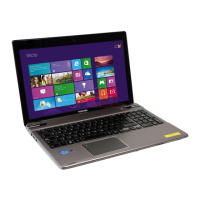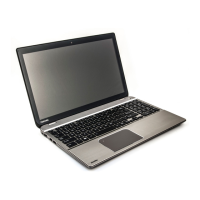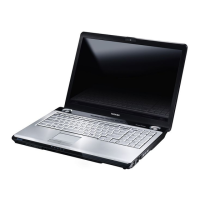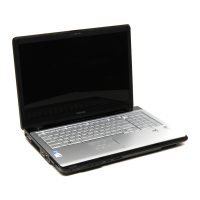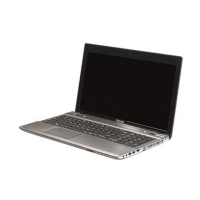
Do you have a question about the Toshiba Satellite P850 Series and is the answer not in the manual?
| Bluetooth | Bluetooth 4.0 |
|---|---|
| Processor | Intel Core i7 or Core i5 |
| RAM | DDR3 |
| Storage | Up to 1TB HDD or 128GB SSD |
| Display | 15.6-inch HD (1366x768) or Full HD (1920x1080) LED-backlit display |
| Graphics | NVIDIA GeForce GT 630M/640M |
| Operating System | Windows 7 or Windows 8 |
| Battery | 6-cell Lithium-ion battery |
| Chipset | Intel HM76 Express |
| Optical Drive | Blu-ray Disc or DVD SuperMulti drive |
| Audio | Harman Kardon speakers |
| Webcam | HD Webcam |
| Networking | Gigabit Ethernet |
| Ports | HDMI, VGA, Headphone/microphone combo jack, SD card reader |
Explains FCC rules and measures to correct interference.
Lists the two conditions for FCC compliance.
Instructions on ensuring proper ventilation to prevent overheating.
Guidance on setting up a suitable environment to protect the computer.
Lists hardware, documentation, and software items included with the computer.
Illustrates how to connect the power cord to the AC adaptor.
Explains how to use Sleep Mode for interruptions and its implications for aircraft.
Shows the front of the computer with the display closed, identifying key slots and indicators.
Explains the function and status indicators for DC IN and battery charge.
Explains the HDMI out port for connecting to display devices.
Details about the rechargeable lithium-ion battery pack's function.
Describes the battery lock mechanism for removing the battery pack.
Details the computer's keyboard layout, keys, and indicators.
Step-by-step guide on swiping a finger for registration and authentication.
Precautions for using the fingerprint sensor to avoid damage or recognition issues.
Instructions on how to use the optical disc drives with different disc sizes.
Usage notes and limitations for the TOSHIBA VIDEO PLAYER.
Usage notes and limitations for the TOSHIBA Blu-ray Disc Player.
Safety warnings and precautions for viewing 3D content.
Specifies the recommended sitting distance and viewing angle for Glasses-Free 3D.
How to set up NVIDIA 3DTV Play for connecting to 3D TVs.
Details Wireless LAN compatibility, standards, and features.
Information about Bluetooth technology, its features, and security.
Step-by-step instructions for connecting the LAN cable.
Precautions for handling and caring for memory cards.
Step-by-step instructions for installing a memory module.
Instructions for connecting the coaxial cable to the TV tuner.
Steps for connecting the monitor cable to the External RGB monitor port.
Step-by-step instructions for connecting the HDMI cable.
Instructions for connecting a security cable to the computer.
How to use the Volume Mixer utility to control audio levels.
Instructions on how to clean the computer and its display screen.
Describes pre-installed utilities and how to start them.
How to register, change, or remove a user password.
Steps to run the HW Setup program.
Steps to register facial data for verification and login.
Sets sensitivity levels for detecting vibrations and impacts.
Instructions on how to create recovery media.
Explains how operating capability and battery status are affected by power conditions.
Explains the status indications of the DC IN/Battery indicator.
Important safety precautions for handling and using the battery pack.
Step-by-step guide for removing the battery pack.
Describes Sleep mode, which maintains data in computer memory.
Guidelines for resolving problems effectively and gathering information.
Simple checks for common problems, like peripheral device connections and setup.
Troubleshooting software-related problems and error messages.
Troubleshooting hardware issues and component checks.
Issues related to the computer's power sources and potential problems.
Procedures for when the battery does not charge.
How to resolve slow HDD performance by defragmenting or reformatting.
Steps to resolve external monitor display issues, including brightness and connection checks.
Steps to take before contacting TOSHIBA support, like checking documentation.
Details ambient temperature, humidity, and altitude requirements.
Details Wireless LAN compatibility and compliance standards.
FCC compliance information for Class B digital devices.




